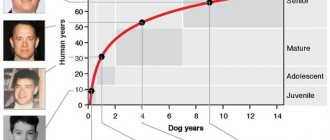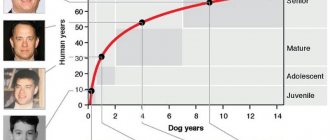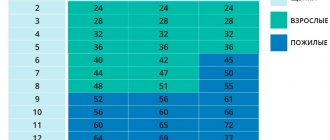Age correspondence table
Also, for your convenience, all calculations can be viewed in the table.
| Number of years | Size | |||
| Small breed dogs | Medium sized dogs | Large | ||
| 1 year | 15 years | 15 years | 15 years | |
| 2 year | 23 years old | 24 years old | 22 years old | |
| 3 years | 28 years | 29 years | 29 years | |
| 4 years | 32 years old | 34 years old | 34 years old | |
| 5 years | 36 years | 37 years | 40 years | |
| 6 years | 40 years | 42 years old | 45 years | |
| 7 years | 44 years old | 47 years old | 50 years | |
| 8 years | 48 years old | 51 years old | 55 years | |
| 9 years | 52 years old | 56 years old | 61 years old | |
| 10 years | 56 years old | 60 years | 66 years old | |
Periods of a dog's life
The entire life of dogs can be divided into several periods:
- Lactic;
- Puppy;
- Teenage;
- Youthful;
- Mature;
- Elderly.
1. The dog experiences growth during the milk, puppy and teenage years. So the smallest dogs, for the most part, fully grow by 10 months. Well, the largest breeds stop growing by 2 years.
2. Adolescence in tiny breeds begins at 10 months and ends on average at 8 years. However, in larger four-legged animals, adolescence ends much earlier; already at 3 years old, some dogs can be called mature, while medium-sized dog breeds go through the stage of adolescence at about 4 - 5 years old.
3. A small breed dog becomes full-fledged and mature after 8 years of age, and this period continues until the 12th year of life. The largest breeds reach maturity at 3 years old, and remain so for up to 6 years. The duration of maturity in average representatives of tetrapods ranges from 7 to 10 years.
4. Naturally, old age also comes to dogs; there is no escape from it. The youngest dog breeds may experience some age-related inconveniences only after 12 years. By the way, pocket dogs, which are constantly in the arms of girls, can live even more than 20 years, which cannot be said about other pets.
Medium-sized dogs begin to age rapidly after 8 to 10 years of age and can live in this state for about several years. Well, the largest four-legged animals already after 6 years enter the phase of old age and the duration of their future life will depend only on proper care.
How to calculate a dog's age
According to a theory that was popular in the last century, one dog year is equivalent to seven human years. True, such a calculation is very conditional and approximate. After all, at one year the pet is already an adult, but according to this version, he gets only seven human years.
Calculating your real age is not that easy. It depends on the size of the animal, its habitat and many other factors. In fact, most dogs are considered seniors by the time they are eight years old.
Rule "7 to 1"
Since the 1950s, a popular calculation of how old a dog was "in human years" has been that 1 dog year is the equivalent of 7 human years. Even though this formula has been around for a surprisingly long time, the reality isn't all that complicated. Kelly M. Cassidy, curator of the Charles R. Connor Museum at Washington State University, which collects research on longevity in dogs, says it's not entirely true that the seven-year rule is wrong. One explanation for how this formula came about is that the 7:1 ratio appears to be based on the statistic that humans once lived to about 70 years of age and dogs to about 10.
William Fortney, a veterinarian at Kansas State University, suggested to the Wall Street Journal that this calculation of a dog's age was simply a marketing ploy. In this way, veterinarians informed the public about how quickly dogs age compared to humans, mainly from a health point of view. This was a way to encourage owners to bring their pets in at least once a year for a general checkup.
Advances in medicine over the years have increased our life expectancy through improved diagnosis and treatment. Veterinary medicine has also made it possible for our pets to increase their life expectancy. When trying to figure out how old your pet is, the old school was 1 year in dog years equal to 7 years in human years. It looks like this kind of fuzzy scale is getting old. Our pets also reach maturity at a certain age, but because they have shorter lifespans, they age faster than us.
Calculating a pet's age gives an idea of what their chronological age is. Finding out a dog's age in human years helps to see them at their actual age as they get older. Using the old formula "1 dog year equals 7 human years" is simple and easy to remember, but does not provide an accurate calculation when comparing a pet's age to a human's. For example, a dog reaching its first birthday can already reproduce, but a 7-year-old child still has a long stage to go through before he reaches this opportunity.
We also recommend reading:
The largest dog breeds What is domestication in animal husbandry Why you should get a cat: reasons voiced by scientists Euthanasia of animals
Existing methods for calculating the age of an animal
There are two main methods for determining the age of a pet by human standards.
Lebeau's theory
In the middle of the last century, a veterinarian from France A. Lebo put forward a theory according to which puppies develop at an accelerated pace. At the same time, he compared the stages of development and growth common to dogs and people.
The following points were taken into account:
- puberty;
- the onset of maturity;
- life expectancy.
Lebo believed that a one-year-old puppy was already 15 years old by human standards. At the age of two, he is already 24 human years old. With each subsequent year, 4 years were added to the age.
Kleiber's Law
According to this theory, the age of a pet directly depends on its size.
According to Kleiber, the pet’s body becomes the same as that of a 78-year-old person at the following stage:
- giant breeds – 10 years;
- large dogs – 12 years;
- average – 14 years;
- small – 15 – 16 years.
Other age-related features in the life of a pet
During the life of a pet, behavioral characteristics are also observed at different stages.
From the moment of birth until 18 days, the puppy is helpless. He is blind, deaf, and completely dependent on his mother. During this period, its main activity is feeding. The purpose of its movement (crawling) is to search for milk. From 15 to 21 days, the puppy gains the ability to see and hear. He runs, jumps, and actively reacts to external stimuli. Conditioned reflexes are being formed, including defensive ones. Starting from the 3rd week, the puppy gains weight rapidly and the brain mass increases. The period from 1.5 to 3 months is considered the most important from the point of view of puppy training. By 12 weeks, mother's guardianship ends and the baby comes under the owner's wing.
It is important at this moment to immediately accustom your pet to the rules established in the house. Mistakes made in parenting during this period can lead to serious problems in the future.
This is especially true for guard and service dogs. The puppy must be taught to respond to its name, and also taught the simplest commands - “place”, “come to me”. The time of life from 3 to 7 months is the period of formation of the nervous system. It is at this age that the dog’s behavioral type is determined – active or passive.
Subsequently, the pet's character changes slightly. Changes occur in older dogs. They become less social, move little, and sleep more.
Age at which the first heat occurs
The first heat in female dogs occurs between 6 months in miniature dogs and 1 year in large breeds. In any case, it occurs after a complete change of teeth.
It may go unnoticed. In order not to miss this moment, the owner needs to note all changes in behavior. Dogs often show aggression towards males. This serves as one of the signs of puberty.
At what age can a dog be spayed?
- The issue of sterilizing a dog depends on whether the animal is planned to be used for breeding. If the answer is yes, sterilization seems advisable in old age, starting from 7-8 years.
- In other cases, to avoid problems with unnecessary pregnancy in females or excessive activity and aggressiveness in males, it is worth considering sterilization (castration) in the early stages of life.
girl
Bitches are usually spayed before their first heat. The age of females at this moment can be from 6 to 12 months. Therefore, if such a decision is made, it is necessary to clarify in advance with the breeder the features of the appearance of the first discharge in a particular breed.
Castrate a male dog
The general recommendation for castration of male dogs is that this procedure is carried out no earlier than 6-7 months. The main factor in determining the timing is the relationship with the pet’s puberty. In large dogs it can be completely completed by 12-18 months.
Age of teeth change
Babies begin to erupt teeth at the age of 12-14 days. By the end of 3 weeks of life, canines erupt, and at 1 month, the front incisors are usually present. The last to appear are the premolars (with the exception of small breeds, whose teeth cut later).
With normal development, 45-60 days after birth, the pet has a full row of milk teeth (28 pieces). The process of changing teeth to molars begins at 4 months and lasts from 2 to 4 months.
Replacement occurs in a different sequence than emergence. The incisors, premolars and molars are replaced first
Primary canines are the last to fall out. It is important to pay increased attention to the oral cavity during this period and, if necessary, remove loose teeth. This is the key to the correct formation of a dog’s bite. It must be scissor-shaped, that is, the upper canines necessarily slightly overlap the lower ones.
Features of the elderly
Old age is characterized by a number of features:
- Medical in nature (deterioration of vision, weakening of muscle structure, thinning of teeth, the appearance of diseases - diabetes, obesity, arthritis);
- Behavioral plan (decreased activity, increased sleep time, the appearance of causeless barking).
During this period, it is recommended to switch the pet to dry food (if previously feeding was provided with natural products). You need to choose special food for older dogs. They contain a full range of vitamins and microelements that support the cardiovascular and skeletal systems of the animal.
How to determine age by external signs
If the age of a pet is not reliably known, it can be determined by a number of external signs:
- muscle tone. Young dogs have well-developed muscles. They are active and spend more time moving than sleeping. Older pets walk little and lie down more. Obesity and muscle tissue atrophy are often observed;
- wool. Young dogs have a soft and silky coat. The older the pet gets, the tougher its coat becomes. If it is dark in color, then gray hair appears on the muzzle;
- eyes. In puppies and young pets they are clear and shiny. In older people, eyes become dull and cloudy. The manifestation of pathologies of the organs of vision is possible.
Cheat sheet for foundling owners
If a new family member is picked up on the street or taken from a shelter, then his age will be determined by the condition of his teeth, eyes and internal organs, as well as the appearance of his skin and fur. Often you cannot do without x-rays and ultrasound, so only a veterinarian will provide accurate data
If a trip to the veterinary clinic is not possible in the coming days, then pay attention to:
- Elasticity and color of wool. Loose skin and gray hair are characteristic of older animals.
- Eyes. The older the dog, the worse his vision and the cloudier his pupils.
- Cleanliness and wear of teeth. Up to 2 months, puppies have milk teeth with snow-white enamel. By 7 months they change to native ones, but do not lose their whiteness. Darkening of the enamel and yellowness indicate that the animal is older than 7 months, but younger than 2 years. From the age of 2 the first tartar appears, and after 5 years there is noticeable wear on the surface of the teeth. The absence of some teeth and an abundance of tartar is observed in dogs over 10 years old.
Please note that the presented pattern directly depends on lifestyle. If a dog has lived on the street for a long time, then the condition of his teeth will be worse than that of a four-legged pupil from a good shelter
Factors influencing a dog's lifespan
On average, animals live between 10-14 years. True, their life expectancy is often shorter. Some individuals can live significantly longer. It is worth understanding what causes this.
How does the size of an animal affect its lifespan?
It has been scientifically proven that the lifespan of an animal directly depends on its size. The body of large dogs wears out faster than miniature dogs. On average, small dogs live one and a half times longer than large pets.
Does breed affect life expectancy?
It has been noted that representatives of different breeds are prone to developing certain diseases. This can be seen in the following example:
- Pekingese are susceptible to pathologies of the cardiovascular and respiratory systems;
- Dachshunds – often face problems with joints and spine;
- Great Danes – representatives of this breed are often diagnosed with arthritis, joint dysplasia, and heart disease.
Accordingly, to a certain extent, the breed still has an impact on the duration and quality of life.











